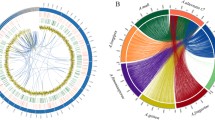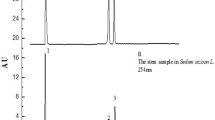Abstract
The aim of this study was to investigate the pathogenicity of Aspergillus alliaceus (Aa), a fungal biocontrol agent, on Orobanche by transcriptomic tests. For this reason, the expression of several genes was analysed comparatively in the experimental (fungi applied) and control (fungi-free) groups. After fungal infection, the expression of antioxidant enzyme genes SOD (Mn-superoxide dismutase), CAT (catalase), and SOD2 (Zn-superoxide dismutase) and the genes GS (Glutamine synthetase), HSP70 (heat-shock protein), and apoptosis [BCL2, BAX, caspase3 (CASP3)], which are related to protein metabolism, were investigated in the both groups. In gene expression studies, gene expression of SOD was almost 2.5 times higher in the experimental group than in the control group (fungus-free, intact), while the expression levels of other antioxidant genes (CAT and SOD2) were significantly reduced. While GS, which is the N and protein metabolism balancer, was found to be relatively low as compared to the control group, however, the level of HSP70 (protein folding, chaperoning) was quite higher than the control. Gene expressions of all apoptotic genes, BAX (=apoptosis suppressive gene), CASP3 and BCL (=apoptosis inducer genes), were significantly lower than control group. All the results found for the control group were determined to be statistically significant. It was concluded that during Aa pathogenesis, (1) the increased SOD value was associated with ROS (reactive oxygen species) threats, (2) the fungi disturbed protein synthesis metabolism, and finally, (3) the inhibited antioxidant and apoptosis-based pathways compared to the control group. These conclusions were discussed in the light of slow but constantly lethal effects of Aa comparatively to other pathogenic fungus, Fusarium.


Similar content being viewed by others
References
Alazem M, Na-Sheng L (2015) Roles of plant hormones in the regulation of host–virus interactions. Mol Plant Pathol 16(5):529–540. doi:10.1111/mpp.12204
Anonymous (2011) Branched broomrape eradication program. In: Proceedings of the Branched Weed Control Conference. Biosecurity SA, Government of Australia, Adelaide, 680–684. Available from URL: http://www.pir.sa.gov.au/biosecuritysa Cited April 22 2014
Augustine SM, Narayan JA, Syamaladevi DP, Appunu C, Chakravarthi M, Ravichandran V, Subramonian N (2015) Erianthus arundinaceus HSP70 (EaHSP70) overexpression increases drought and salinity tolerance in sugarcane (Saccharum spp. hybrid). Plant Sci 232:23–34. doi:10.1016/j.plantsci.2014.12.012
Aybeke M (2016) Several pesta tablet trials with Aspergillus alliaceus thom & church for effective underground and aboveground Orobanche L. biocontrol. Trak Univ J Nat Sci 17(1):65–70
Aybeke M (2017) Fusarium infection causes genotoxic disorders and antioxidant-based damages in Orobanche spp. Microbiol Res 201:46–51. doi:10.1016/j.micres.2017.05.001
Aybeke M, Şen B, Ökten S (2014) Aspergillus alliaceus, a new potential biological control of the root parasitic weed Orobanche. J Basic Microbiol 54:93–101. doi:10.1002/jobm.201300080
Aybeke M, Şen B, Ökten S (2015) Pesta granule trials with Aspergillus alliaceus for the biocontrol of Orobanche spp. Biocontrol Sci Technol 25(7):803–813. doi:10.1080/09583157.2015.1018813
Boari A, Vurro M (2004) Evaluation of Fusarium spp and other fungi as biological control agents of broomrape (Orobanche ramosa). Biol Control 30:212–219. doi:10.1016/j.biocontrol.2003.12.003
Boston RS, Viitanen PV, Vierling E (1996) Molecular chaperones and protein folding in plants. Plant Mol Biol 32:191–222
Choi HW, Hwang BK (2015) Molecular and cellular control of cell death and defense signaling in pepper. Planta 241:1–27. doi:10.1007/s00425-014-2171-6
Doganlar O, Doganlar ZB, Tabakcioglu K (2015) Effects of permissible maximum-contamination levels of VOC mixture in water on total DNA, antioxidant gene expression, and sequences of ribosomal DNA of Drosophila melanogaster. DOI, Environ Sci Pollut Res. doi:10.1007/s11356-015-4741-y
Doganlar ZB, Doganlar O, Ongoren G (2016) The protective role of Quercetin against Arsenic-induced genotoxicity in Drosophila melanogaster. Int J Sci Technol Res 2(1):37–49
Eizenberg H, Hershenhorn J, Ephrath JE (2009) Factors affecting the efficacy of Orobanche cumana chemical control in sunflower. Weed Res 49:308–315. doi:10.1111/j.1365-3180.2009.00701.x
Fagard M, Launay A, Clément G, Courtial J, Dellagi A, Farjad M, Krapp A, Soulié MC, Masclaux-Daubresse C (2014) Nitrogen metabolism meets phytopathology. J Exp Bot 65(19):5643–5656. doi:10.1093/jxb/eru323
Feng JL, Wang K, Liu X, Chen SN, Chen JS (2009) The quantification of tomato microRNAs response to viral infection by stem-loop real-time RT-PCR. Gene 437:14–21. doi:10.1016/j.gene.2009.01.017
Frugoli JA, Zhong HH, Nuccio ML, McCourt P, McPeek MA, Thomas TL et al (1996) Catalase is encoded by a multigene family in Arabidopsis thaliana (L.) Heynh. Plant Physiol 112:327–336
Fujita J, Crane AM, Souza MK, Dejosez M, Kyba M, Flavell RA, Thomson JA, Zwaka TP (2008) Caspase activity mediates the differentiation of embryonic stem cells. Cell Stem Cell 2(6):595–601. doi:10.1016/j.stem.2008.04.001
Gadjev I, Stone JM, Gechev TS (2008) Programmed cell death in plants: new insights into redox regulation and the role of hydrogen peroxide. Int Rev Cell Mol Biol 270:87–144. doi:10.1016/S1937-6448(08)01403-2
Gahl RF, Dwivedi P, Tjandra N (2016) Bcl-2 proteins bid and bax form a network to permeabilize the mitochondria at the onset of apoptosis. Cell Death Dis 7:e2424. doi:10.1038/cddis.2016.320
Gill SS, Tuteja N (2010) Reactive oxygen species and antioxidant machinery in abiotic stress tolerance in crop plants. Plant Physiol Biochem 48:909–930. doi:10.1016/j.plaphy.2010.08.016
Goldwasser Y, Eizenberg H, Golan S, Kleifeld Y (2003) Control of Orobanche crenata and Orobanche aegyptiaca in parsley. Crop Prot 22:295–305. doi:10.1016/S0261-2194(02)00152-7
Hershenhorn J, Eizenberg H, Dor E, Kapulnik Y et al (2009) Broomrape management in tomato. Weed Res 49(Suppl. 1):34–47. doi:10.1111/j.1365-3180.2009.00739.x
Hodosy AS, Hornok L (1983) Occurrence of hyperparasite Fusarium species and their use for control of broomrape on tomato. Proc Int Conf Integr Plant Prot 4:48–52
Kang G, Li G, Guo T (2014) Molecular mechanism of salicylic acid-induced abiotic stress tolerance in higher plants. Acta Physiol Plant 36(9):2287–2297
Kayihan DS, Kayihan C, Ciftci YO (2016) Excess boron responsive regulations of antioxidative mechanism at physio-biochemical and molecular levels in Arabidopsis thaliana. Plant Physiol Biochem 109:337–345. doi:10.1016/j.plaphy.2016.10.016
Kazan K (2015) Diverse roles of jasmonates and ethylene in abiotic stress tolerance. Trends Plant Sci 20(4):219–229. doi:10.1016/j.tplants.2015.02.001
Klink VP, Overall CC, Alkharouf NW, MacDonald MH, Matthews BF (2007) Laser capture microdissection (LCM) and comparative microarray expression analysis of syncytial cells isolated from incompatible and compatible soybean (Glycine max) roots infected by the soybean cyst nematode (Heterodera glycines). Planta 226:1389–1409. doi:10.1007/s00425-007-0578-z
Kohlschmid E, Sauerborn J, Müller-Stöver D (2009) Impact of Fusarium oxysporum on the holoparasitic weed Phelipanche ramosa: biocontrol efficacy under field-grown conditions. Weed Res 49(Suppl. 1):56–65. doi:10.1111/j.1365-3180.2009.00743.x
Korkmaz S, Kormaz H (2017) Effect of alterations in apoptotic pathway on development of metabolic syndrome in patients with psoriasis vulgaris. Transl Res 176:6. doi:10.1111/bjd.15185
Kyndt T, Denil S, Haegeman A, Trooskens G, Bauters L, Van Criekinge W, De Meyer T, Gheysen G (2012) Transcriptional reprogramming by root knot and migratory nematode infection in rice. New Phytol 196:887–900. doi:10.1111/j.1469-8137.2012.04311.x
Müller-Stöver D, Kroschel J (2005) The potential of Ulocladium botrytis for biological control of Orobanche spp. Biol Control 33:301–306. doi:10.1016/j.biocontrol.2005.03.006
Müller-Stöver D, Kroschel J, Thomas H, Sauerborn J (2002) Chlamydospores of Fusarium oxysporum Schlecht f.sp. orthoceras (Appel & Wollenw.) Bilai as inoculum for wheat-flour-kaolin granules to be used for biological control of Orobanche cumana Wallr. Eur J Plant Pathol 108:221–228
Nguyen CT, Truc TL, Gyu-Lee Kim S, Pyo Dong-Kwon R (2015) Korean Red Ginseng inhibits apoptosis in neuroblastoma cells via estrogen receptor b-mediated phosphatidylinositol-3 kinase/Akt signaling. J Ginseng Res 39:69–75. doi:10.1016/j.jgr.2014.06.005
Nirenberg HI (1976) Untersuchungen u ber die morphologische und biologische Differenzierung in der Fusarien Sektion Liseola. Mitt. Biol. Bundesanstalt Land- und Forstwirtsch Berlin-Dahlem, Germany 169:1–117
O’Brien JA, Daudi A, Butt VS, Bolwell GP (2012) Reactive oxygen species and their role in plant defence and cell wall metabolism. Planta 236:765–779. doi:10.1007/s00425-012-1696-9
Peperzak V, Slinger E, Ter Burg J, Eldering E (2017) Functional disparities among BCL-2 members in tonsillar and leukemic B-cell subsets assessed by BH3-mimetic profiling. Cell Death Differ 24(1):111–119. doi:10.1038/cdd.2016.105
Pérez-de-Luque A, Rubiales D, Cubero JI, Pres MC et al (2005) Interaction between Orobanche crenata and its host legumes: unsuccessful haustorial penetration and necrosis of the developing parasite. Ann Bot 95:935–942. doi:10.1093/aob/mci105
Sang QQ, Shu S, Shan X, Guo SR, Sun J (2016) Effects of exogenous spermidine on antioxidant system of tomato seedlings exposed to high temperature stress. Russ J Plant Physiol 63(5):645–655
Seabra AR, Carvalho HG (2015) Glutamine synthetase in Medicago truncatula, unveiling new secrets of a very old enzyme. Front Plant Sci 6:578. doi:10.3389/fpls.2015.00578
Seabra AR, Silva LS, Carvalho HG (2013) Novel aspects of glutamine synthetase (GS) regulation revealed by a detailed expression analysis of the entire GS gene family of Medicago truncatula under different physiological conditions. BMC Plant Biol 13:137. doi:10.1186/1471-2229-13-137
Shabana YM, Müller-Stöver D, Sauerborn J (2003) Granular Pesta formulation of Fusarium oxysporum f.sp. orthoceras for biological control of sunflower broomrape: efficacy and shelf-life. Biol Control 26:189–201. doi:10.1016/S1049-9644(02)00130-5
Sousa EO, Miranda CMBA, Nobre CB, Boligon AA, Athayde ML, Costa JGM (2015) Phytochemical analysis and antioxidant activities of Lantana camara and Lantana montevidensis extracts. Ind Crop Prod 70:7–15. doi:10.1016/j.indcrop.2015.03.010
Sudati JH, Vieira FA, Pavin SS, Mundstock Dias GR, Seeger RL, Golombieski R, Athayde ML, Soares FA, Teixeira Rocha JB (2013) Valeriana officinalis attenuates the rotenone-induced toxicity in Drosophila melanogaster. Neurotoxicology 37:118–126. doi:10.1016/j.neuro.2013.04.006
Venuprasad MP, Kandikattu HK, Razack S, Khanum F (2014) Phytochemical analysis of Ocimum gratissimum by LC-ESI–MS/MS and its antioxidant and anxiolytic effects. S Afr J Bot 92:151–158. doi:10.1016/j.sajb.2014.02.010
Wang FB, Liu JC, Zhou LJ, Pan G, Li ZW, Zaidi SHR, Cheng FM (2016) Senescence-specific change in ROS scavenging enzyme activities and regulation of various SOD isozymes to ROS levels in psf mutant rice leaves. Plant Physiol Biochem 109:248–261. doi:10.1016/j.plaphy.2016.10.005
Ward J, Forcat S, Beckmann M et al (2010) The metabolic transition during disease following infection of Arabidopsis thaliana by Pseudomonas syringae pv. tomato. Plant J 63:443–457. doi:10.1111/j.1365-313X.2010.04254.x
Yu Y, Xiao J, Yang Y, Bi C, Qing L, Tan W (2015) Ss-Bi1 encodes a putative BAX inhibitor-1 protein that is required for full virulence of Sclerotinia sclerotiorum. Physiol Mol Plant P 90:115–122. doi:10.1016/j.pmpp.2015.04.005
Zhao Y, Jingxin C, Xiaoya T, Xiaojie Z, Linchun M (2014) The possible role of BAX and BI-1 genes in chilling-induced cell death in cucumber fruit. Acta Physiol Plant 36:1345–1351
Zonno MC, Vurro M (2002) Inhibition of germination of Orobanche ramosa seeds by Fusarium toxins. Phytoparasitica 30:519–524
Acknowledgement
I thank Prof. Dr. Oğuzhan DOĞANLAR for his valuable comments and TUBAP (Trakya University, Scientific Researches Foundations) with the Project Number TUBAP 2014-82.
Author information
Authors and Affiliations
Corresponding author
Rights and permissions
About this article
Cite this article
Aybeke, M. Transcriptomic effects of Aspergillus alliaceus on Orobanche during its pathogenesis. J Plant Dis Prot 125, 33–39 (2018). https://doi.org/10.1007/s41348-017-0122-8
Received:
Accepted:
Published:
Issue Date:
DOI: https://doi.org/10.1007/s41348-017-0122-8




